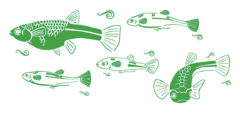Connect the Public with Flowing Santa Cruz River

Last November, the endangered Gila topminnow, a native Sonoran Desert fish, was discovered in the Santa Cruz River in Tucson. Now a team of artists, scientists, and advocates is celebrating its return home.
In June, stenciled artwork of the fish and the story of its return were painted along The Loop multi-use path and in select urban locations as a way to connect the public with the fish and the flowing Santa Cruz River.
A collaboration between Pima County, Sonoran Institute, and Tucson artist Kimi Eisele, the project aims to expand public awareness of the flowing water and the lush ribbon of green vegetation this water supports along the Santa Cruz River in Pima County, from Tucson to Marana.
The artist, Kimi Eisele, has a history of creating arts-based engagements to connect the public to environmental issues and Sonoran Desert plant and animal species.
“I kept thinking about the incredible story of this tiny fish coming back to the ecosystem because of our treated wastewater. The species seemed like the perfect messenger to tell the public about the river — that it is actually flowing through part of Tucson — and creating a healthy habitat for wildlife, plants, and people,” said Eisele.
Eisele created stencil artwork of the Gila topminnow and wrote its story in six short “chapters” to alert cyclists, runners, walkers, and others using the section of the Loop Path along the Santa Cruz, of its existence in the river. Over time, additional appearances of the fish and its story will occur in urban locations to further connect the public the river.
Since the 1970s, the release of highly treated wastewater (effluent) has created a flowing river and a green riparian corridor extending over 20 miles. This habitat was enhanced in 2013 when Pima County upgraded its wastewater reclamation facilities. This cleaner water has increased the replenishment of our groundwater aquifers, brought back diverse aquatic wildlife (including five species of fish), reduced odors, and created a place for human recreation and enjoyment.
Sonoran Institute and Pima County have collaborated on a series of reports (A Living River) since 2012 to describe river conditions and the impact of improved effluent quality before, during, and after the $600 million dollar wastewater reclamation facilities upgrades completed by Pima County in December 2013. These were modeled on a series of reports Sonoran Institute pioneered for the Santa Cruz River near Nogales.
“We’ve been thrilled with the success of our partnership with Pima County to expand the Living River reports to Tucson. We’ve been looking for new and innovative ways to connect the public with this stretch of the river and to highlight the improvements that we’ve seen,” said Claire Zugmeyer, ecologist at Sonoran Institute.
Pima County’s Office of Sustainability and Conservation embraced the chance to partner on the project. Staff scientists considered its message of revival complementary to their own mission to restore the river’s biodiversity and improve conditions in wetlands fed by the Santa Cruz.
“Kimi is an extremely diverse and creative artist who works in that interplay of humans and the environment. In essence, she is a conservation artist, which really jibes with the conservation biology work we do,” said County biologist Brian Powell. “Sonoran Institute brings a strong and much-needed voice for river conservation. Together, the artist, government and non-profit can use our respective skills to highlight the environmental, economic, and cultural benefits of this amazing community asset.”
A series of public events in Tucson will inaugurate the artwork, including a commemorative Gila Topminnow cocktail at EXO Bar, a costumed bicycle ride, and a riverside DIY dinner. Project collaborators encourage the public to share photos of the fish, artwork, and related activities on social media with the tag #GilaTopminnow.
The project was funded by the Catalyst Initiative of the Center for Performance and Civic Practice, a national initiative supporting place-based project teams comprised of an individual artist and a civic (community, non-profit, or municipal) partner to conceive and execute a small-scale local arts-based project created in response to an expressed need by the partner.
Gila Topminnow Celebrations:
Gila Topminnow Cocktails & Bike Decorating Party
Thursday, June 14; 5-8pm (All ages welcome)
EXO Bar, 403 N 6th Ave.
Gussy up your bike for the June 16 ride and toast to the topminnow with a commemorative special cocktail made by EXO bartenders.
Gila Topminnow Returns Bike Ride
Saturday, June 16; 8-10am
Loop Path, east side of Santa Cruz River
Join a parade of topminnows on bicycle to view fish artwork along Loop Path and celebrate its return to the river.
For a 4.7-mile ride, meet at 8 am on the west side of Santa Cruz River and Speedway Blvd. From there, ride will go north on east side of The Loop. For a shorter ride, join us anywhere along the east side of The Loop. Destination: Outfall, beginning of flowing water on east side of The Loop, .2-mile north of Sweetwater Drive. Map.
Gila Topminnow Riverside Picnic Dinner
Saturday, June 23; 6-9pm
Christopher Columbus Park, Ramada #5
4600 N. Silverbell Rd., Tucson, AZ 85745
Bring your own dinner (plus blanket, chairs, table, candles and a flashlight) for a gathering to celebrate the Gila topminnow. This is a leave-no-trace event. Pack out everything you pack in. Respect the no-open container law.
Additional information about all three events can be found online at the Sonoran Institute or Kimi Eisele’s website.
Contacts:
Sonoran Institute
Ian Dowdy
602-393-4310 ext. 308
idowdy@sonoraninstitute.org
Pima County Office of Sustainability & Conservation
Brian Powell
520-305-2025
Brian.Powell@pima.gov
Kimi Eisele (Artist)
520-882-6092
kimieisele@gmail.com
